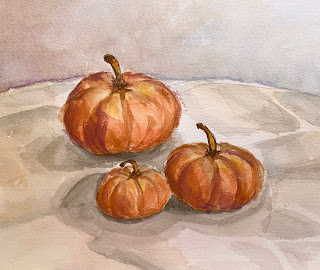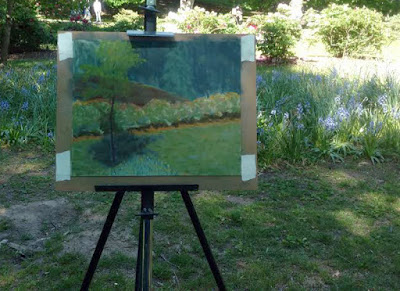The inner self emerges, despite our best efforts to keep it stuffed down.
 |
| Pumpkins by Maggie Daigle. |
If the weather holds today, I’ll be painting with my pal Ken DeWaard. We don’t worry about painting the same subject. He doesn’t want to paint like me, and—because he won’t let me copy off his paper—I don’t paint like him.
This week I assigned my Zoom classes to paint pumpkins. They’re in season, after all. After I’d had that brilliant idea, I had to figure out something interesting to say on the subject. That was harder, but I eventually managed to marry pumpkins to a Big Idea in Painting.
 |
| Pumpkins by Mary Silver. |
Color temperature is especially complicated on an orange (or blue) object, because they’re at the outside edges of that useful artistic convention we call “warm and cool.” If you’re managing the color of light by simply modulating all your colors with the same tinted white pigment, it’s no great problem. But if, like the Impressionists, you’re dialing around the color wheel to control the color of light, you run into a problem. There’s simply nowhere warmer than orange or cooler than ultramarine blue. That gave me a subject to talk about regarding pumpkins.
My students then proceeded to paint. And that’s where the real learning started… for me.
 |
| A leaning tower of pumpkins by Kathy Mannix (unfinished). |
I wasn’t optimistic about the results. After all, how interesting could two dozen still-life paintings of pumpkins be? It’s not as if the gourds were out in the field waiting to be gathered up, on plants, buried in leaves, or stacked in innovative ways. Shorn of context, they would be plopped on tables from Maine to Texas. I expected to harvest a crop of very similar paintings.
Instead, there was as much variety as there would have been if I’d suggested self-portraits.
 |
| Pumpkins by Patricia Mabie. |
Kathy Mannix stacked hers in a leaning tower. Samantha East added a large squash to break up the composition. Lorraine Nichols laid her gourds out on a textile printed with pumpkins; Maggie Daigle and Patricia Mabie played the stripes of their gourds against the stripes of textiles. Carrie O’Brien’s pumpkins were reflected in the bowl of a silver spoon. Somehow, each painting was reflective of each artist, “warts and all,” as Lori Galan joked about her own painting.
 |
| Pumpkins by Yvonne Bailey. |
The arts are the voice of our inner self, but painting is uniquely self-expressive. It’s influenced fairly equally by both our conscious and subconscious minds. Contrary to what you might think, our subconscious expression gets stronger the more we gain technical skill. When our process runs quietly in the background, there’s space and time for our souls to start speaking.
For example, it’s impossible to mistake a Caravaggio for an Artemisia Gentileschi, even though both painted Biblical subjects, belong to the same general broad movement in art and underwent similar training. It’s not just the lighting or drafting that immediately tell us which is which, either. The very personality of their work is different.
 |
| One very warty pumpkin by Lori Capron Galan (unfinished). |
There are many reasons for a teacher to avoid trying to create mini-me painters in the studio, but it’s a pointless exercise anyway. The inner self emerges despite our best efforts to keep it stuffed down.
I’m also reminded—again—that there’s little point in trying to predict the outcome of my ideas. Sometimes I’ll put something out that I think is dreck, and it catches the public imagination. Sometimes, I’ll labor long and hard on something I think is brilliant, but nobody else much cares. I’ve learned to just cast my bread upon the waters and let the results take care of themselves.







